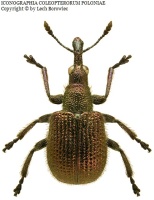
Русские, остановите эту войну! Спасите Свободную Украину!
Russians, stop this war! Save Free Ukraine!
Biodiversity Map
Taxa

Involvulus — subordinate taxa:
Taxon count: 1
-
Arthropodaphylum
Click to switch
to select orders
and filters > -
Hexapodasubphylum
Click to switch
to select orders
and filters > -
Insectaclass
Click to switch
to select orders
and filters > -
Coleopteraorder
Click to set
as the main taxon
and as a base
← of the left panel > -
Polyphagasuborder
Click to set
as the main taxon
and as a base
← of the left panel > -
Cucujiformiaseries
Click to set
as the main taxon
and as a base
← of the left panel > -
Curculionoideasuperfamily
Click to set
as the main taxon
and as a base
← of the left panel > -
Rhynchitidaefamily
Click to set
as the main taxon
and as a base
← of the left panel > -
Rhynchitinaesubfamily
Click to set
as the main taxon
and as a base
← of the left panel > -
Rhynchitinitribe
Click to set
as the main taxon
and as a base
← of the left panel > -
Involvulusgenus
Click to set
as the main taxon
and as a base
← of the left panel > -
Involvulussubgenus
Click to set
as the main taxon
and as a base
← of the left panel >
PL
YES
name status: valid name
BioMap ID: 1026649
taxon code: 4852
taxonomy checked: YES
Data on distribution in Poland

Statistics
- Records: 156
- Publications: 69
- Collections: 8
- Publication authors: 57
- Illustrations (iconography): 1
- Photos (specimen/observation): 1
Taxon description
Gatunek rozmieszczony prawie w całej Europie, na północ docierający do Wysp Brytyjskich, Danii, południowych obszarów Fennoskandii, a na wschód przez Syberię aż do Japonii. W Polsce występuje na całym obszarze kraju, nie notowany tylko z Puszczy Białowieskiej, Niziny Sandomierskiej i Kotliny Nowotarskiej. Żyje na różnych gatunkach roślin z rodzajów: głóg — Crataegus L., jarząb — Sorbus L., wiśnia — Cerasus Mill., śliwa — Prunus L., jabłoń — Malus Mill. Postacie dojrzałe pojawiają się w kwietniu i spotykane są do września. Samice składają jaja do niedojrzałych owoców, w których larwy żerują kilka tygodni, następnie odbywają przeobrażenie w glebie. Nowe pokolenie ukazuje się we wrześniu i przezimowuje w powierzchniowej warstwie gleby.
Illustrations
... browse
 Involvulus
Involvuluscupreus
Photos
... browse
 Involvulus
Involvuluscupreus
External data sources
- Ostatnie rekordy
-
1098461
 ×
× Rhynchitidae: Involvulus cupreus, UA, Brzuchowice ad Lwów, 1933, leg. J. Schnaider, coll. IBL, Zakład Ochrony Lasu, Sękocin: Gottwald
Rhynchitidae: Involvulus cupreus, UA, Brzuchowice ad Lwów, 1933, leg. J. Schnaider, coll. IBL, Zakład Ochrony Lasu, Sękocin: Gottwald -
1098460
 ×
× Rhynchitidae: Involvulus cupreus, PL, Bydgoszcz, Zacisze, 1928, leg. A. Gottwald, coll. IBL, Zakład Ochrony Lasu, Sękocin: Gottwald
Rhynchitidae: Involvulus cupreus, PL, Bydgoszcz, Zacisze, 1928, leg. A. Gottwald, coll. IBL, Zakład Ochrony Lasu, Sękocin: Gottwald -
1098459
 ×
× Rhynchitidae: Involvulus cupreus, PL, Bydgoszcz, Zacisze, 1928, leg. A. Gottwald, coll. IBL, Zakład Ochrony Lasu, Sękocin: Gottwald
Rhynchitidae: Involvulus cupreus, PL, Bydgoszcz, Zacisze, 1928, leg. A. Gottwald, coll. IBL, Zakład Ochrony Lasu, Sękocin: Gottwald -
1098458
 ×
× Rhynchitidae: Involvulus cupreus, PL, Bydgoszcz, Zacisze, 1928, leg. A. Gottwald, coll. IBL, Zakład Ochrony Lasu, Sękocin: Gottwald
Rhynchitidae: Involvulus cupreus, PL, Bydgoszcz, Zacisze, 1928, leg. A. Gottwald, coll. IBL, Zakład Ochrony Lasu, Sękocin: Gottwald -
1098457
 ×
× Rhynchitidae: Involvulus cupreus, UA, Brzeżany, Gadzia Góra, 1928, leg. A. Gottwald, coll. IBL, Zakład Ochrony Lasu, Sękocin: Gottwald
Rhynchitidae: Involvulus cupreus, UA, Brzeżany, Gadzia Góra, 1928, leg. A. Gottwald, coll. IBL, Zakład Ochrony Lasu, Sękocin: Gottwald -
1098456
 ×
× Rhynchitidae: Involvulus cupreus, PL, Ndl. Dębowo, Kozielec, 1939, leg. A. Gottwald, coll. IBL, Zakład Ochrony Lasu, Sękocin: Gottwald
Rhynchitidae: Involvulus cupreus, PL, Ndl. Dębowo, Kozielec, 1939, leg. A. Gottwald, coll. IBL, Zakład Ochrony Lasu, Sękocin: Gottwald -
944619
 ×
× Rhynchitidae: Involvulus cupreus, SK, Tatry Zachodnie, Ticha dolina I, UTM , 1917, leg. S. Knutelski, coll. TANAP (Knutelski 2005)
Rhynchitidae: Involvulus cupreus, SK, Tatry Zachodnie, Ticha dolina I, UTM , 1917, leg. S. Knutelski, coll. TANAP (Knutelski 2005) -
791897
 ○
○ Rhynchitidae: Involvulus cupreus, PL, Pojezierze Mazurskie, Biebrzański P.N., podlaskie, UTM FE13, 1996, leg. M. Wanat (Wanat 2005d)
Rhynchitidae: Involvulus cupreus, PL, Pojezierze Mazurskie, Biebrzański P.N., podlaskie, UTM FE13, 1996, leg. M. Wanat (Wanat 2005d) -
791537
 ○
○ Rhynchitidae: Involvulus cupreus, PL, Pojezierze Mazurskie, Biebrzański P.N., podlaskie, UTM FE13, 1996, leg. M. Wanat (Wanat 2005d)
Rhynchitidae: Involvulus cupreus, PL, Pojezierze Mazurskie, Biebrzański P.N., podlaskie, UTM FE13, 1996, leg. M. Wanat (Wanat 2005d) -
791350
 ○
○ Rhynchitidae: Involvulus cupreus, PL, Pojezierze Mazurskie, Biebrzański P.N., podlaskie, UTM FE13, 1996, leg. M. Wanat (Wanat 2005d)
Rhynchitidae: Involvulus cupreus, PL, Pojezierze Mazurskie, Biebrzański P.N., podlaskie, UTM FE13, 1996, leg. M. Wanat (Wanat 2005d) - ... more
- Powiązane publikacje
-
Mazur M.A. 2011c. Weevils (Coleoptera: Curculionoidea) of the Stobrawski Landscape Park. Pol. Pismo Ent., 80(2):321-342.
 full text
full text Show records
Show records -
Marczak D., Lasecki R., Mazur M.A., Wanat M. 2011. Leaf-Rolling Weevils (Curculionoidea: Attelabidae, Rhynchitidae) in Kampinos National Park. Nature Journal, 44:135-140.
 Show records
Show records -
Sprick P., Floren A. 2007. Canopy leaf beetles and weevils in the Białowieża and Borecka Forests in Poland (Col., Chrysomeloidea, Curculionoidea). Pol. Pismo Ent., 76:75-100.
 Show records
Show records -
Maciejowski W. 2007. Wpływ cech środowiska przyrodniczego na rozmieszczenie wybranych grup chrząszczy (Coleoptera) w południowej części Wyżyny Krakowsko-Częstochowskiej. Wydawnictwo Uniwersytetu Jagiellońskiego. 177 pp.
 Show records
Show records -
Gosik R. 2006d. Weevils (Curculionoidea) of the middle part of the Bug River Valley. Ann. UMCS, C, 61:7-69.
 Show records
Show records - ... more
- Powiązane zbiory
-
ISEZ PAN
 Show records
Show records -
Kuśka A.*
 Show records
Show records -
Muz. Górnośląskie, Bytom: Mączyński
 Show records
Show records -
TANAP
 Show records
Show records -
Wanat M.*
 Show records
Show records - ... more
- Wykaz powiązanych pozycji
-
Curculionoidea of Poland
 Show records
Show records -
Weevils of the Tatra Mts.
 Show records
Show records






